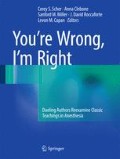Abstract
An 83-year-old man with a history of hypertension, hyperlipidemia, and previous transient ischemia attack without any residual neurological deficits is brought to the operating room from the emergency department for hip arthroplasty to repair a traumatic femoral neck fracture. He describes an exercise tolerance of 2–3 blocks that is limited by knee and back pain. His EKG shows sinus tachycardia at 105 beats per minute, left axis deviation, and left ventricular hypertrophy. His chest X-ray demonstrates mild pulmonary congestion, and laboratories reveal a hemoglobin concentration of 8.5 g/dl and normal electrolytes with elevated creatinine of 1.4 mg/dl. His vital signs in the operating room are HR 105, BP 179/80, RR 18, Sp02 of 96 % on 2 L of nasal cannula. After routine induction of anesthesia, the patient remains hypotensive despite aggressive fluid resuscitation of 2 L and frequent boluses of phenylephrine. An arterial line, another large bore IV, and a phenylephrine drip are started with marginally improved blood pressure. An arterial blood gas demonstrates a stable hemoglobin of 8.0 g/dl. The anesthesiologist, who is basic transesophageal echocardiography (TEE) certified, places a TEE probe to evaluate the cause of the persistent hypotension. The TEE examination demonstrates a dilated left atrium and global systolic hypokinesis of the left ventricle with estimated ejection fraction of 30–35 %. Inotropic support is initiated, patient is taken to the catheterization laboratory for coronary angiogram, and the surgery is postponed to after the optimization of his cardiac status.
Access this chapter
Tax calculation will be finalised at checkout
Purchases are for personal use only
References
Thys DM, Abel MD, Brooker RF, Cahalan MK, Connis RT, Duke PG, et al. Practice guidelines for perioperative transesophageal echocardiography: an updated report by the American Society of Anesthesiologists and the Society of Cardiovascular Anesthesiologists task force on transesophageal echocardiography. Anesthesiology. 2010;112:1084–96.
Shillcutt SK, Markin NW, Montzingo CR, Brakke TR. Use of rapid “rescue” perioperative echocardiography to improve outcomes after hemodynamic instability in noncardiac surgical patients. J Cardiothoracic Vasc Anesthesia. 2012;26:362–70.
Canty DJ, Royse CF, Kilpatrick D, Bowman L, Royse AG. The impact of focused transthoracic echocardiography in the pre-operative clinic. Anesthesia. 2012;67(6):618–25.
Kallmeyer IJ, Collard CD, Fox JA, Body SC, Shernan SK. The safety of intraoperative transesophageal echocardiography: a case series of 7200 cardiac surgical patients. Anesth Analg. 2001;92(5):1126–30.
Memtsoudis SG, Rosenberger P, Loffler M, Eltzschig HK, Mizuguchi A, Shernan SK, Fox JA. The usefulness of transesophageal echocardiography during intraoperative cardiac arrest in non-cardiac surgery. Anesth Analg. 2006;102:1653–7.
Rebel A, Klimkina O, Hassan ZU. Transesophageal echocardiography for the noncardiac surgical patient. Int Surg. 2012;97:43–55.
Porter TR, Shillcutt SK, Adams MS, Desjardins G, Glas KE, Olson JJ, et al. Guidelines for the use of echocardiography as a monitor for therapeutic intervention in adults: a report from the American Society of Echocardiography. JASE. 2015;28:40–56.
Reeves ST, Finley AC, Skubas NJ, Swaminathan M, Whitley WS, Glas KE, Council on Perioperative Echocardiography of the American Society of Echocardiography, Society of Cardiovascular Anesthesiologists, et al. Basic perioperative transesophageal echocardiography examination: a consensus statement of the American Society of Echocardiography and the Society of Cardiovascular Anesthesiologists. J Am Soc Echocardiogr. 2013;26(5):443–56.
Sandham JD, Hull RD, Brant RF, Knox L, Pineo GF, Doig CJ, et al. A randomized, controlled trial of the use of pulmonary artery catheters in high-risk surgical patients. N Engl J Med. 2003;348:5–14.
Author information
Authors and Affiliations
Corresponding author
Editor information
Editors and Affiliations
Rights and permissions
Copyright information
© 2017 Springer International Publishing Switzerland
About this chapter
Cite this chapter
Rong, L.Q. (2017). When Can Transesophageal and Trans-Thoracic Echocardiography Be Useful in a Non-Cardiac Case?. In: Scher, C., Clebone, A., Miller, S., Roccaforte, J., Capan, L. (eds) You’re Wrong, I’m Right. Springer, Cham. https://doi.org/10.1007/978-3-319-43169-7_11
Download citation
DOI: https://doi.org/10.1007/978-3-319-43169-7_11
Published:
Publisher Name: Springer, Cham
Print ISBN: 978-3-319-43167-3
Online ISBN: 978-3-319-43169-7
eBook Packages: MedicineMedicine (R0)

